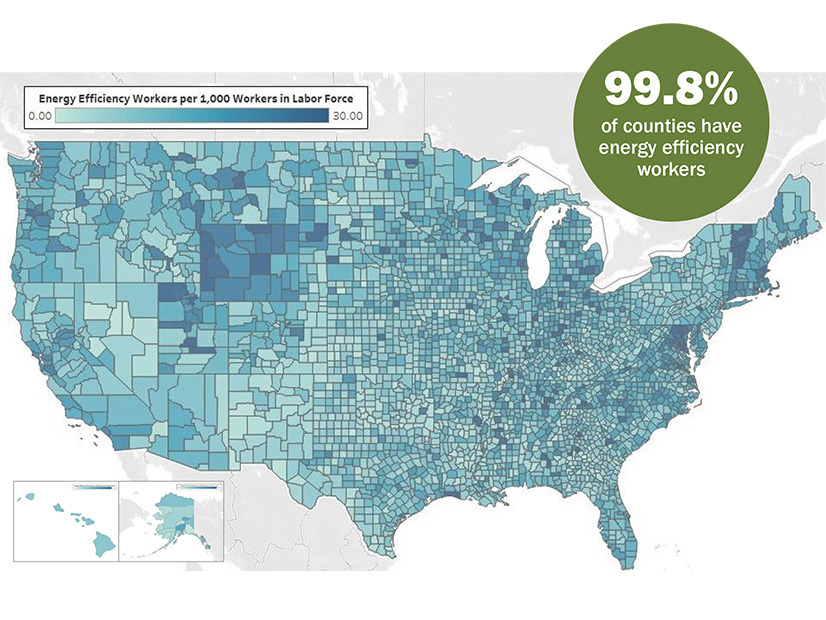The webinar on Tuesday was ostensibly about energy efficiency jobs, but the discussion with Rep. Peter Welch (D-Vt.) inevitably drifted to the current battle over the bipartisan infrastructure bill and the Democrats’ $3.5 trillion budget reconciliation bill now unfolding in Congress.
Welch reported he was one of about 10 lawmakers on a Zoom call with President Joe Biden and Vice President Kamala Harris on Monday, and “he and she were both very realistic. He’s committed to everything in his $3.5 trillion program. But the reality is Sen. [Joe] Manchin thinks that is too expensive, and Sen. [Kyrsten] Sinema thinks that, too,” Welch said. “And we’ve got 48 votes in the Senate without them, so we’ve got to come to some resolution.
“There was a realistic discussion about the urgency of Democrats making the painful choices that we have to,” he said, although no specific programs that might be trimmed were mentioned. “This bill is largely paid for, but on climate initiatives, where the clock is ticking, we’re going to do everything we can as soon as we can, no matter what.”
Welch’s remarks came as Biden and progressives in the House of Representatives were trying to find a compromise figure, as reported in the Washington Post, with Biden suggesting $1.9 trillion to $2.2 trillion and the progressives countering with $2.5 trillion to $2.9 trillion.
Welch was optimistic that energy efficiency measures he has sponsored would survive the hard decision-making to come. One, the bipartisan Hope for Homes Act, would provide incentives for homeowners to make energy-efficient upgrades to their homes, while the Federal Buildings Clean Jobs Act, sponsored with Rep. John Sarbanes (D-Md.), would fund energy-efficient retrofits of government buildings, he said.
“Energy efficiency does three things,” Welch said. “One, it saves money; if you reduce the use of whatever fuel it is, you’re saving money. No. 2, it increases local jobs. … In each of our congressional districts where there are energy efficiency initiatives, it results in good jobs for good people. And third, it reduces carbon emissions.
“What is so tremendous about so many of the energy efficiency initiatives is that they have to be done at a micro level,” he said. “They have to be done in your home; they have to be done in the homes of black and brown citizens. And the more we have folks in the neighborhood participating in the program, the more we have local workers getting the benefits of the buildout, the more successful the program is going to be.”
Home Retrofits and Climate Goals
The problem with energy-efficient jobs, however, is that they are hard to count, said Philip Jordan, vice president of BW Research, which conducts an annual energy efficiency job survey for E2 and E4TheFuture, both clean energy advocacy groups that focus on economic and job growth.
“The Bureau of Labor Statistics doesn’t track energy efficiency as a standalone [category] because much of the work is done across other industry sectors,” Jordan said during the Tuesday webinar, rolling out the results of this year’s survey. “So, these are electricians and plumbing and HVAC and engineers and architects and assemblers.”
Based on interviews with more than 30,000 businesses across the country, the 2021 survey report counted 2.1 million Americans working in energy efficiency, accounting for more jobs than any other sector of the energy industry. The industry took a hit during the first stages of the Covid-19 pandemic, but it has been slowly rebounding, according to the report.
Retrofitting all 111 million U.S. residential units — homes and apartments — built before 2000 could create more than 1 million full-time jobs for 10 years, while saving Americans an estimated $66 billion per year on utility bills, the report says.
Efficiency may also be critical for the U.S. and individual states to meet carbon-reduction goals. The American Council for an Energy Efficient Economy (ACEEE) has estimated that robust energy efficiency measures could get the U.S. halfway to its 2050 climate goals, yet few states have specific energy-efficiency targets. A recent report from the ACEEE found that out of 17 states with 100% clean energy standards, only two — Virginia and Washington State — have specific energy-efficiency goals.
Similarly, while 24 states and Washington, D.C. have set carbon reduction goals, only New York and D.C. have set targets for decreases in energy consumption. Adoption of such targets could reduce the cost of meeting clean energy standards by managing demand on the grid, accelerate building and transportation electrification and “advance equitable decarbonization strategies” to ensure all consumers benefit from the clean energy transition, the ACEEE report says.



